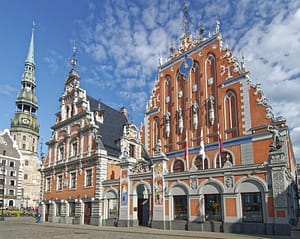Even before the German occupation of Latvia in the 13th century, the country thrived as an important trading post on the Baltic Sea. Most tribes were self-governing until the arrival of the German traders in the 1200’s. Riga was established for trade and as an important military base for northern crusades, which can be explored at the National History Museum of Latvia.
The 17th and 18th century saw great conflict in the Baltic region, as Sweden, Poland and the newcomer Russia, played a deadly and devastating game of tug-o-war. Eventually, much of eastern Latvia was taken under Swedish reign, but by 1795, the entire region fell under the control of Russia, following the Great Northern War. The Museum of the Occupation of Latvia is another important landmark in Riga, documenting the historical struggles between major European powers.
During the First World War, Germany seized control after the Bolshevik revolutions forced Russia to secede its power. However, in 1918, Latvia received independence following the Treaty of Versailles. The highly urbanized and industrialized country prospered, although this was short lived, as Russia once again seized control of Latvia in 1941, becoming one of the 15 states of the USSR. Sweeping changes were made, as “Sovieticization” altered the face of Latvia’s social and cultural norms. Mass exoduses took place with people fleeing to Germany or Sweden, while others were forced into Siberia as prisoners against the USSR military.
It wasn’t until Mikhail Gorbachev’s leadership that Latvia saw signs of hope. Russian government reforms led to greater freedom in Latvia, such as the use of their national flag in 1990 and the establishment of the Popular Front of Latvia party in the 1990’s. Full independence was granted in August, 1991, although this was not taken lightly by the USSR, and military was sent into Riga in an attempt to overthrow the democratically elected government. The Museum of the Barricades of 1991 details the events leading up to and during this tumultuous time.
By 1993, the Lat currency was introduced into the economy, and the nation experienced strong economic growth and prosperity. In 2004, Latvia’s goals of joining NATO and the European Union were realized, despite its close proximity and historical ties with Russia. In 2008, the Latvian economy was hit hard by the worldwide financial crisis, leading to unprecedented unemployment rates from which they are still trying to recover. In addition, citizenship issues have become a focus in recent years, especially when it comes to Russian-Latvian displacement.
Despite its prickly history, Latvia is a proud nation, and its citizens certainly show this. Even though the USSR occupation led to the suppression of many important cultural highlights, the 1990’s saw a re-establishment of their national identity. Many folk songs, dances and music that was influenced by Baltic Germans between the 13th and 19th centuries were reborn.
During Russian occupation, Latvia was forced to adopt the Soviet language and art. However, there were “underground” songs and dances developed in the 1970’s and 1980’s, which made fun of the Soviet regime that can still be heard today. More than 30,000 of these are known to be in existence which date back more than one thousand years.

